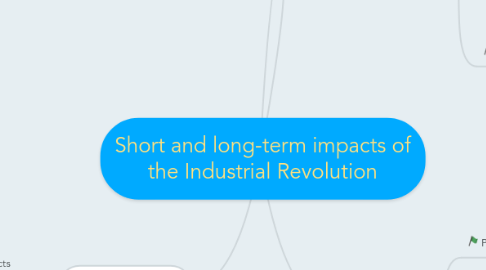
1. Global landscape growth and change
1.1. Positive Impacts
1.1.1. Increased awareness of environmental sustainability
1.1.2. Increased engineering capacity to mitigate natural disasters and irrigate crops
1.2. Negative Impacts
1.2.1. Increased use of fossil fuels saw an increase in smog and respiratory disease as well as pollution
1.2.2. Increase in consumerism and waste land fill - the first department stores were created in response to the desire to buy the newly affordable mass-produced goods
1.2.3. Forest clearing for agricultural land and raw materials became common and habitats were destroyed
1.2.4. Water Pollution occurred there was little government regulation of business waste disposal practices
1.2.5. Urbanisation saw a growth in cities and towns which led to cramped and unhygienic living conditions for the working class
2. Communication
2.1. Positive Impacts
2.1.1. Development of new technologies such as telegraph and other communications methods meant that communication could be done almost instantaneously over large distances.
2.1.2. Trade, migration to and administration of the colonies were facilitated by improved communication
2.2. Negative Impacts
2.2.1. Colonies were further exploited by the European powers
3. Transport
3.1. Positive Imacts
3.1.1. Development of new technologies such as trains and steam powered ships made the world a smaller place - could travel from A to B much quicker
3.1.2. Vacations became affordable and practical among the working class
3.1.3. Colonies like Australia saw a great deal of development - aided by the gold rush
3.2. Negative Impacts
3.2.1. Indigenous populations in colonised areas were exploited and marginalised as the colonies grew
3.2.2. New imperialism was enabled by increased capacity to source raw materials and send goods to new markets
4. Social Revolution
4.1. Positive Impacts
4.1.1. The development of capitalism fueled industrial growth and saw the growth and rise of the merchant class
4.1.2. People gained social mobility - increasingly they were not locked into a social status but could move around between them
4.1.3. It became more acceptable to work for a living during this time
4.1.4. The development of socialism saw workers banding together to achieve better working conditions - trade unions
4.2. Negative Impacts
4.2.1. Capitalism saw the growth of the urban poor - many were forced of the farms and into dangerous and low paid factory jobs
4.2.2. Many industrialists became enormously wealthy at the cost of the working class who were paid very little for a difficult work
4.2.3. Children and women were extensively used as it was cheaper to employ them than an adult male - men were often out of work and crime grew as a result
